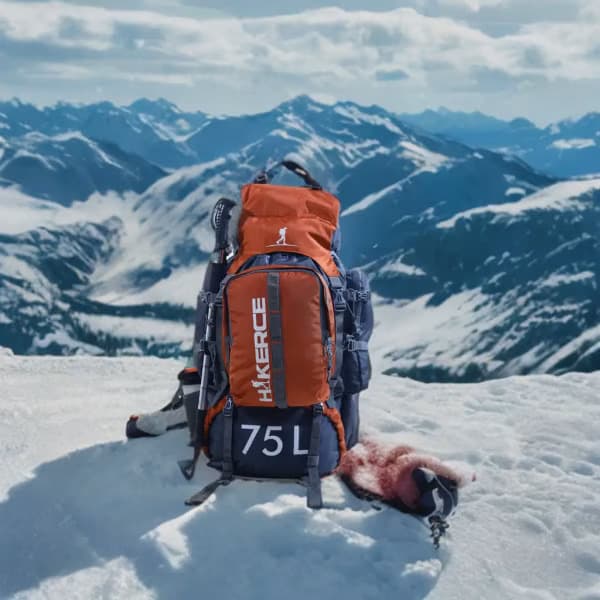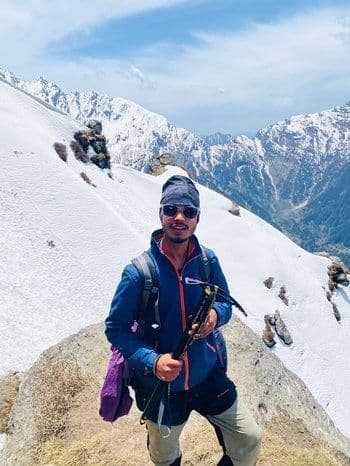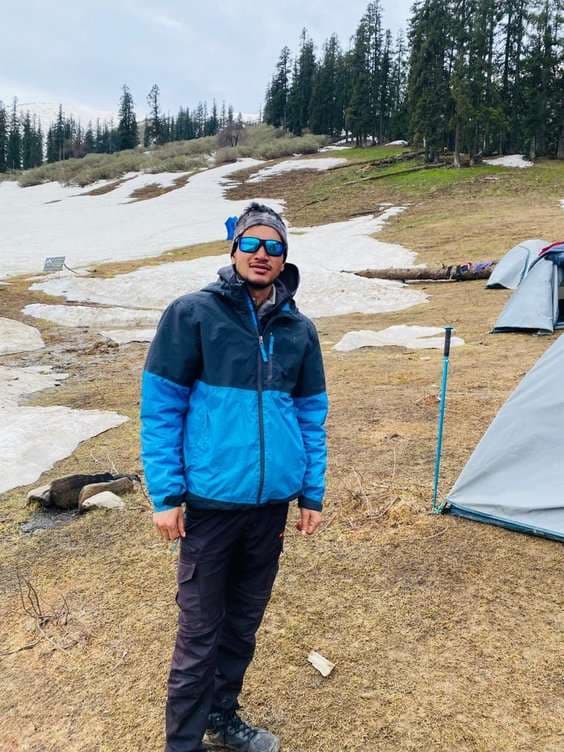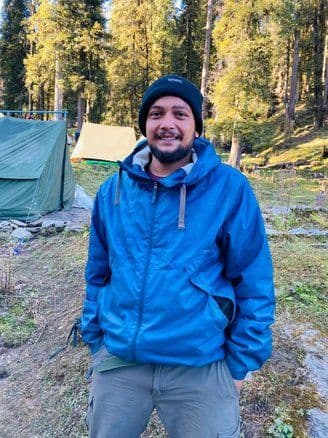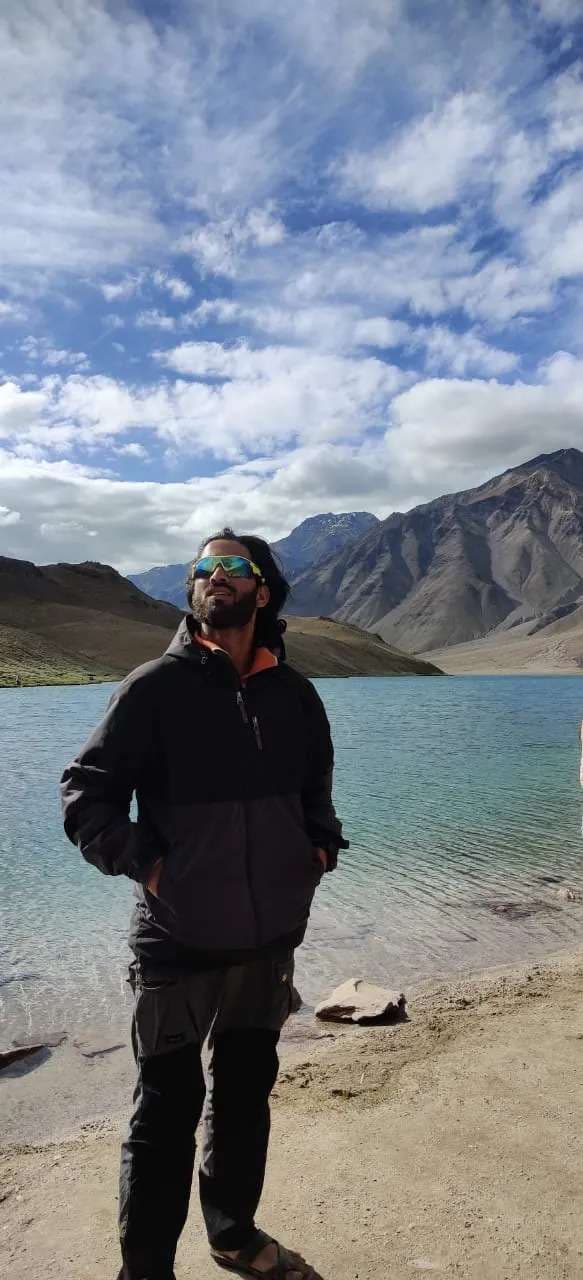Kamet is the second-highest peak in the Garhwal region of the Indian Himalayas and is a prominent mountain in the Zaskar Range. Kamet is located in the Chamoli district of the Indian state of Uttarakhand, within the Garhwal region of the Western Himalayas. It is part of the Zaskar Range. Kamet stands at an elevation of approximately 7,756 meters (25,446 feet) above sea level, making it the second-highest peak in the Indian Himalayas after Kangchenjunga. Kamet is surrounded by other significant peaks in the region, including Mana Peak (also known as Chaukhamba II), Abi Gamin, and Mukut Parbat. The region is characterized by rugged terrain, glaciers, and high-altitude plateaus. Climbing Kamet is considered challenging due to its high altitude, technical climbing sections, and variable weather conditions. It requires advanced mountaineering skills and experience.
Kamet gained prominence in the early 20th century as British and European mountaineers explored the Himalayas. It was first surveyed in 1855 by the British surveyor Andrew Waugh. The first serious attempt to climb Kamet was made in 1907 by the British climbers T. G. Longstaff, M. P. Knowles, and C. F. Meade. However, they were unsuccessful in reaching the summit. In 1931, a Franco-Swiss expedition led by Charles Pathe reached the summit of Kamet, making it the first successful ascent of the mountain. The climbers were Paul Bauer, Raymond Lambert, and Quentin Theodore Riley. The successful ascent of Kamet marked an important achievement in the history of Himalayan mountaineering.
It is 25 days trek approximately. May-June and September-October are the main season to do the expedition because there are favorable climate and temperature for the trekkers. Temperature is around (5°C to 10°C) (-2°C to -15°C) mostly. Kamet has since attracted climbers from around the world, and it continues to be a challenging objective for mountaineers. Kamet Mountain and the surrounding region are known for their stunning natural beauty and challenging climbing opportunities. The history of Kamet's exploration and ascent reflects the spirit of adventure and mountaineering in the Indian Himalayas. Today, Kamet remains a sought-after peak for experienced climbers looking to test their skills and achieve high-altitude summits in this breathtaking part of the world.
Best time for Mount Kamet Expedition
The best time for the expedition of Kamet Mountain, like many high-altitude peaks in the Indian Himalayas, is during the pre-monsoon and post-monsoon seasons. These seasons typically offer more stable weather conditions and favorable climbing conditions. Here are the two primary timeframes to consider for a Kamet Mountain Expedition:
1. Post-Monsoon Season (Late August to October):
Late August to October is generally considered the best time for climbing Kamet Mountain.
The post-monsoon season offers stable weather with clear skies, which is crucial for safe and successful climbing.
Snow and ice conditions on the mountain are more predictable during this period.
The temperatures are relatively milder, with daytime temperatures ranging from -5°C to 5°C (23°F to 41°F) at higher altitudes.
The post-monsoon season allows for better acclimatization and reduced risk of avalanches and snowstorms.
2. Pre-Monsoon Season (May to Early June):
The pre-monsoon season, from May to early June, is another window of opportunity for climbing Kamet Mountain.
During this period, the weather is relatively stable, and the mountain is less crowded than in the post-monsoon season.
Snow and ice conditions may still be favorable for climbing, but there may be more snow on the mountain compared to the post-monsoon season.
Daytime temperatures range from
-10°C to 0°C (14°F to 32°F
) at higher altitudes.
It's essential to keep in mind that the weather in the Himalayas can be unpredictable, and conditions can change rapidly at high altitudes. Therefore, it's crucial to monitor weather forecasts and be prepared for adverse weather conditions, even during the recommended climbing seasons. Additionally, consult with experienced mountaineering guides and expedition organizers for the most up-to-date information and guidance on the best timing for your Kamet Mountain Expedition.
Safety should always be the top priority, and climbers should be prepared for a range of challenges, including altitude-related issues and variable weather, regardless of the season chosen for the expedition.
How to reach Dehradun
Dehradun, the capital city of the Indian state of Uttarakhand, is well-connected by various modes of transportation. Here's how to reach Dehradun:
By Air: Jolly Grant Airport (DED): The nearest airport to Dehradun is the Jolly Grant Airport, located approximately 30 kilometers (about 19 miles) from the city center. It is a domestic airport with regular flights connecting Dehradun to major cities in India, including Delhi, Mumbai, Bangalore, and more. From the airport, you can hire a taxi or take a pre-paid taxi service to reach Dehradun city.
By Train: Dehradun is well-connected by train to various cities across India. The city's main railway station is Dehradun Railway Station (station code: DDN). Several trains, including Shatabdi and Jan Shatabdi Express, connect Dehradun to Delhi, Kolkata, Mumbai, and other major cities. The railway station is located in the heart of Dehradun, making it convenient to access the city center.
By Road: Dehradun is accessible by road from various parts of North India. The city is well-connected by national highways, making it accessible by bus, car, or taxi.
From Delhi: The most common route is to drive from Delhi to Dehradun via NH 44 (previously NH 72). The distance is approximately 250 kilometers, and the journey takes around 5-6 hours by car or bus, depending on traffic conditions.
From Haridwar and Rishikesh: Dehradun is about 54 kilometers (around 34 miles) from Haridwar and 43 kilometers (about 27 miles) from Rishikesh. You can hire a taxi or take a bus from these towns to reach Dehradun.
By Bus: Dehradun is well-connected to nearby cities and towns in Uttarakhand and other states by a network of state-run and private bus services. You can find both regular and luxury buses for your journey. ISBT Dehradun (Inter-State Bus Terminal) is the main bus terminal in the city.
By Car: If you prefer a private vehicle, you can drive to Dehradun from nearby cities and towns. The road network is generally good, but it's essential to be prepared for hilly terrain and varying road conditions, especially if you are traveling during the monsoon season.
Things to carry for Mount Kamet Expedition
Climbing Kamet Mountain in the Indian Himalayas is a challenging and high-altitude endeavor that requires careful preparation and appropriate gear. Here's a list of essential items and equipment you should carry for a Kamet Expedition:
1. Clothing:
Base Layers: Moisture-wicking thermal tops and bottoms to manage sweat and maintain body warmth.
Insulating Layers: Down or synthetic insulated jacket and pants for added warmth at higher altitudes.
Hardshell Jacket and Pants: Waterproof and windproof outer layers to protect against rain, snow, and wind.
Climbing Suit: A one-piece climbing suit designed for high-altitude expeditions.
Headwear: Warm hat, balaclava, and sun hat for protection from the elements.
Gloves: Insulated and waterproof gloves for hand protection.
2. Footwear:
Mountaineering Boots: Insulated, high-altitude mountaineering boots suitable for extreme cold and technical climbing.
Gaiters: Waterproof gaiters to keep snow and debris out of your boots.
Socks: Moisture-wicking and warm socks designed for high-altitude climbing.
3. Climbing Gear:
Harness: A climbing harness for safety during technical sections.
Helmet: A climbing helmet to protect against falling objects.
Crampons: Technical crampons designed for high-altitude use.
Ice Axe: A technical ice axe for snow and ice climbing.
Ascender and Descender: For rope work and rappelling.
Carabiners, Slings, and Prusiks: Essential climbing hardware.
Ropes: Appropriate climbing ropes for the expedition.
Climbing Protection: Depending on the route, bring protection devices like ice screws and snow pickets.
Avalanche Safety Gear: If applicable, carry avalanche transceivers, probes, and shovels.
4. Camping Gear:
Tent: A sturdy, high-altitude tent suitable for extreme conditions.
Sleeping Bag: A high-quality, cold-rated sleeping bag.
Sleeping Pad: Insulated sleeping pad for warmth and comfort.
Cooking Equipment: Lightweight stoves, cookware, and utensils for preparing meals at high altitudes.
Food and Hydration: High-energy, high-calorie foods, and a water filtration system or purification tablets.
Backpack: A mountaineering backpack to carry your gear during the climb.
5. Navigation and Safety:
Maps and Compass: Detailed topographic maps of the area and a reliable compass.
GPS Device: For accurate navigation and tracking.
Headlamp: With extra batteries for nighttime climbing.
First Aid Kit: A comprehensive kit with essentials for high-altitude injuries and ailments.
Communication: Satellite phone or two-way radios for emergency communication.
6. Personal Items:
Sunglasses: High-quality glacier sunglasses with UV protection.
Sunscreen: High SPF sunscreen to protect against strong mountain sun.
Lip Balm: To prevent chapped lips in dry, high-altitude conditions.
Toiletries: Basic hygiene items like toothbrush, toothpaste, and biodegradable soap.
Personal Medications: Any prescribed medications or personal medical supplies.
7. Miscellaneous:
Repair Kit: Tools and materials for equipment repairs.
Duct Tape: Useful for quick fixes in the field.
Trash Bags: To pack out all waste and leave no trace.
Cash: For emergencies and incidentals.
Before your Kamet Expedition, it's essential to consult with experienced mountaineers, guides, or the expedition organizer to ensure you have all the necessary gear and equipment tailored to the specific conditions and route. Proper gear preparation is critical for your safety and success on this challenging high-altitude climb.
How to prepare for Mount Kamet Expedition
Preparing for an expedition to Mount Kamet, one of the challenging peaks in the Indian Himalayas, requires careful planning, physical conditioning, and the acquisition of necessary skills and equipment. Here's a comprehensive guide on how to prepare for a successful Mount Kamet Expedition:
1. Physical Fitness:
Start a comprehensive fitness regimen well in advance of your expedition. Focus on cardiovascular endurance, strength training, flexibility, and stamina.
Incorporate aerobic exercises like running, cycling, and hiking to improve your cardiovascular fitness. Include strength training exercises to build core strength and muscular endurance.
Regularly engage in uphill trekking and hiking to simulate the conditions of high-altitude climbs.
2. Altitude Acclimatization:
Allow adequate time for altitude acclimatization during the trek to the base camp and higher camps. Rushing the ascent can lead to altitude-related illnesses.
Monitor team members for symptoms of altitude sickness, such as headaches, nausea, and dizziness, and respond promptly with appropriate actions.
3. Technical Skills:
High-altitude climbing requires technical skills in ice and rock climbing, crevasse rescue, rope work, and navigation.
Consider enrolling in mountaineering courses or training programs to acquire these skills if you are not already proficient.
Practice using crampons, ice axes, ropes, and other climbing equipment.
4. Mental Preparation:
Develop a strong mental attitude and resilience. High-altitude climbs can be physically and mentally challenging.
Familiarize yourself with the potential risks and challenges of high-altitude climbing and how to mitigate them.
Practice mental techniques like meditation and visualization to stay calm under pressure.
5. Gear and Equipment:
Invest in high-quality climbing gear and clothing suited for high-altitude conditions. This includes insulated mountaineering boots, down clothing, harness, helmet, and technical climbing equipment.
Ensure all gear is well-fitted and in excellent condition.
Learn how to use and maintain your equipment.
6. Health and Nutrition:
Prioritize your health by getting regular check-ups and vaccinations. Consult a healthcare professional to assess your fitness for high-altitude climbs.
Plan a balanced diet rich in carbohydrates, proteins, and healthy fats to maintain energy levels. Stay hydrated at all times and avoid alcohol and tobacco, which can impair acclimatization.
7. Permits and Logistics:
Obtain all necessary permits and permissions for the expedition well in advance. Ensure you are aware of any local regulations and restrictions.
Make logistical arrangements for transportation, accommodations, and support staff, if applicable.
8. Emergency Preparedness:
Develop an emergency plan that includes communication devices, first aid supplies, and evacuation procedures.
Learn basic wilderness first aid and rescue techniques.
9. Team and Leadership:
Assemble a competent and experienced team, including guides and support staff, who are familiar with the region and the climb.
Establish effective communication and teamwork among team members.
10. Stay Informed:
Stay updated on weather forecasts and current conditions in the region. Be prepared to adjust your plans if necessary.
Safety factors of Mount Kamet Expedition
Safety is of paramount importance during an expedition to Mount Kamet, one of the challenging peaks in the Indian Himalayas. The high-altitude and technical nature of the climb make it crucial to prioritize safety at all times. Here are key safety factors to consider for a Mount Kamet Expedition:
1. Experienced Guides and Support Team:
Engage experienced and certified mountaineering guides who are knowledgeable about the region, familiar with the climbing route, and trained in rescue procedures.
Ensure the expedition includes a support team, including porters and cooks, to assist with logistics and emergencies.
2. Acclimatization:
Allow adequate time for altitude acclimatization during the trek to the base camp and higher camps. Rushing the ascent can lead to altitude-related illnesses.
Monitor team members for symptoms of altitude sickness, such as headaches, nausea, and dizziness, and respond promptly with appropriate actions.
3. Emergency Communication:
Carry communication devices such as satellite phones, two-way radios, or emergency beacons to maintain contact with base camp and seek assistance if needed.
Establish clear communication protocols within the team for emergencies and regular check-ins.
4. Weather Monitoring:
Stay informed about weather forecasts and updates. Sudden weather changes, storms, and heavy snowfall are common in high-altitude regions.
Be prepared to alter your plans or wait out adverse weather conditions when necessary.
5. Avalanche Awareness:
Educate the team about avalanche risks and safe practices. Avoid avalanche-prone areas whenever possible.
Carry avalanche safety equipment, such as transceivers, probes, and shovels, and know how to use them.
6. Equipment and Gear:
Ensure all climbing equipment and gear are in excellent condition and properly maintained.
Conduct regular gear checks and inspections during the expedition.
Use appropriate safety gear such as helmets and harnesses.
7. Emergency Medical Supplies:
Carry a comprehensive first aid kit, including medications for altitude sickness, pain relief, and common ailments.
Train team members in basic wilderness first aid and evacuation procedures.
8. Ropes and Rope Safety:
Use ropes and harnesses for sections that require protection, and follow proper rope techniques.
Establish belay systems and anchors for safety during technical climbing.
9. Navigation and Route Knowledge:
Ensure team members are proficient in map reading, GPS use, and route finding.
Familiarize yourself with the climbing route, potential hazards, and escape routes.
10. Emergency Evacuation Plan:
Develop a clear and well-practiced plan for emergency evacuations, including helicopter rescues if needed.
Share your itinerary and expected return date with a trusted contact who can raise the alarm in case of delays or emergencies.
11. Group Dynamics:
Encourage open dialogue and decision-making based on the best interests of safety. Foster effective teamwork and communication among team members.
12. Leave No Trace Ethics:
Follow Leave No Trace principles to minimize your environmental impact and preserve the pristine wilderness of the Himalayas.
13. Decision-Making:
Be prepared to make difficult decisions, including turning back if conditions become too hazardous.
Avoid summit fever, where the desire to reach the summit overrides safety considerations.
14. Training and Skills:
Ensure that all team members possess the necessary mountaineering skills, including crevasse rescue, rope work, and technical climbing.
Regularly practice safety drills and emergency scenarios.



